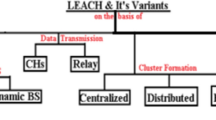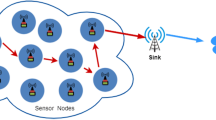Abstract
In wireless sensor networks, sensors at different locations in the field use different energy levels to propagate sensing data back to the sink or base station. This causes unbalanced energy usage among sensors and also lowers the network lifetime. Currently there are several techniques to mitigate this problem, such as deploying multiple sinks, adding more sensors on heavy traffic areas, or managing the size of clusters depending on the distance from sensor to sink. In this paper, we propose a distributed algorithm and protocol called Multipath Energy Balancing (MEB) to mitigate unbalanced energy usage in clustered wireless sensor networks using multi-path and multi-hop, with a transmission power control approach. The network field is divided into regions, where the ratio of inter-region transmission traffic from all cluster head sensors in one region to other cluster head sensors in the two regions in front can be pre-computed and pre-programmed into the sensors to ease sensor deployment. To further prolong network lifetime, we also present a simple heuristic algorithm to procrastinate cluster formation and routing. Simulation results show that MEB can balance energy much better than Energy-efficient Clustering (EC) and Balancing Energy Consumption (BEC) solutions. It also has a longer network lifetime than EC and BEC protocols, especially when the required cluster size is small. Procrastinating cluster formation and routing also can further improve the network lifetime.













Similar content being viewed by others
References
Heinzelman, W. B., Chandrakasan, A. P., & Balakrishnan, H. (2002). An application-specific protocol architecture for wireless microsensor networks. IEEE Transactions on Wireless Communications, 1(4), 660–670.
Mhatre, V., & Rosenberg, C. (2004). Homogeneous vs heterogeneous clustered sensor networks: A comparative study. In 2004 IEEE international conference on communications (Vol. 6, pp. 3646–3651).
Farooq, M. O., Dogar, A. B., & Shah, G. A. (2010). Mr-leach: Multi-hop routing with low energy adaptive clustering hierarchy. In 2010 fourth international conference on sensor technologies and applications (SENSORCOMM) (pp. 262–268).
Wei, D., Jin, Y., Vural, S., Moessner, K., & Tafazolli, R. (2011). An energy-efficient clustering solution for wireless sensor networks. IEEE Transactions on Wireless Communications, 10(11), 3973–3983.
Chauhan, S. S., & Gore, M. M. (2015). Balancing energy consumption across network for maximizing lifetime in cluster-based wireless sensor network. CSI Transactions on ICT, 3(2), 83–90.
Lian, J., Naik, K., & Agnew, G. B. (2006). Data capacity improvement of wireless sensor networks using non-uniform sensor distribution. International Journal of Distributed Sensor Networks, 2(3), 121–145.
Chatterjee, P., & Das, N. (2015). Multiple sink deployment in multi-hop wireless sensor networks to enhance lifetime. In Applications and innovations in mobile computing (AIMoC), 2015 (pp. 48–54).
Gu, Y., Ji, Y., Li, J., & Zhao, B. (2013). ESWC: Efficient scheduling for the mobile sink in wireless sensor networks with delay constraint. IEEE Transactions on Parallel and Distributed Systems, 24(7), 1310–1320.
Sharma, S., Puthal, D., Jena, S. K., Zomaya, A. Y., & Ranjan, R. (2017). Rendezvous based routing protocol for wireless sensor networks with mobile sink. The Journal of Supercomputing, 73(3), 1168–1188.
Kumar, D., Aseri, T. C., & Patel, R. B. (2009). EEHC: Energy efficient heterogeneous clustered scheme for wireless sensor networks. Computer Communications, 32(4), 662–667.
Biradar, R. V., Sawant, S. R., Mudholkar, R. R., & Patil, V. C. (2011). Inter-intra cluster multihop-leach routing in self-organizing wireless sensor networks. International Journal of Research and Reviews in Computer Sciences, 2(1), 88–95.
Ye, M., Li, C., Chen, G., & Wu, J. (2005). EECS: An energy efficient clustering scheme in wireless sensor networks. In PCCC 2005. 24th IEEE international performance, computing, and communications conference, 2005 (pp. 535–540).
Chen, G., Li, C., Ye, M., & Jie, W. (2009). An unequal cluster-based routing protocol in wireless sensor networks. Wireless Networks, 15(2), 193–207.
Xia, H., Zhang, R., Jia, Y., & Pan, Z. (2016). Energy-efficient routing algorithm based on unequal clustering and connected graph in wireless sensor networks. International Journal of Wireless Information Networks, 23(2), 141–150.
Tran-Quang, V., Nguyen Huu, P., & Miyoshi, T. (2011). A transmission range optimization algorithm to avoid energy holes in wireless sensor networks. IEICE Transactions on Communications, E94B(11), 3026–3036.
Song, C., Liu, M., Cao, J., Zheng, Y., Gong, H., & Chen, G. (2009). Maximizing network lifetime based on transmission range adjustment in wireless sensor networks, computer communications. Computer Communication, 32(11), 1316–1325.
Tanessakulwattana, S., Pornavalai, C., Chakraborty, G., & Naik, S. (2012). Optimal multi-path energy-aware routing protocol for wireless sensor networks. In 2012 9th international conference on electrical engineering/electronics, computer, telecommunications and information technology (ECTI-CON) (pp. 1–4).
Chakraborty, G. (2010). Optimum cluster size for cluster based communication in wireless sensor network. In UBICOMM 2010. 4th international conference on mobile ubiquitous computing, systems, services and technologies, 2010 (pp. 328–333).
Kacimi, R., Dhaou, R., & Beylot, A.-L. (2013). Load balancing techniques for lifetime maximizing in wireless sensor networks. Ad Hoc Networks, 11(8), 2172–2186.
Chen, Y., & Nasser, N. (2006). Energy-balancing multipath routing protocol for wireless sensor networks. In Proceedings of the 3rd international conference on quality of service in heterogeneous wired/wireless networks, QShine ’06, New York, NY. ACM.
Lu, Y. M., & Wong, V. W. S. (2007). An energy-efficient multipath routing protocol for wireless sensor networks: Research articles. International Journal of Communication Systems, 20(7), 747–766.
Sharma, S., & Jena, S. K. (2015). Cluster based multipath routing protocol for wireless sensor networks. ACM SIGCOMM Computer Communication Review, 45(2), 14–20.
Jerbi, W., Guermazi, A., & Trabelsi, H. (2016). O-LEACH of routing protocol for wireless sensor networks. In 2016 13th international conference on computer graphics, imaging and visualization (CGiV) (pp. 399–404).
Haupt, J., Bajwa, W. U., Rabbat, M., & Nowak, R. (2008). Compressed sensing for networked data. IEEE Signal Processing Magazine, 25(2), 92–101.
Xiang, L., Luo, J., & Rosenberg, C. (2013). Compressed data aggregation: Energy-efficient and high-fidelity data collection. IEEE/ACM Transactions on Networking, 21(6), 1722–1735.
Heinzelman, W. B. (2000). Application-specific protocol architectures for wireless networks. Ph.D. thesis, Massachusetts Institute of Technology.
Younis, O., & Fahmy, S. (2004). HEED: A hybrid, energy-efficient, distributed clustering approach for ad hoc sensor networks. IEEE Transactions on Mobile Computing, 3(4), 366–379.
Jin, Y., Wei, D., Vural, S., Gluhak, A., & Moessner, K. (2011). A distributed energy-efficient re-clustering solution for wireless sensor networks. In 2011 IEEE global telecommunications conference (GLOBECOM 2011) (pp. 1–6).
Author information
Authors and Affiliations
Corresponding author
Rights and permissions
About this article
Cite this article
Tanessakulwattana, S., Pornavalai, C. Multipath energy balancing for clustered wireless sensor networks. Wireless Netw 25, 2537–2558 (2019). https://doi.org/10.1007/s11276-018-1684-5
Published:
Issue Date:
DOI: https://doi.org/10.1007/s11276-018-1684-5




